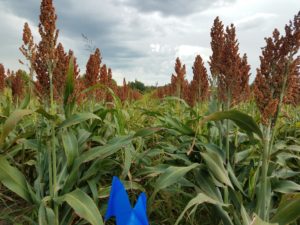Organic grain, soybean study establishes early production recommendations
Writer: Kay Ledbetter, 806-677-5608, [email protected]
Contact: Dr. Nithya Rajan, 979-845-0360, [email protected]
Dr. Muthu Bagavathiannan, 979-845-5375, [email protected]
Dr. Ronnie Schnell, 979-845-2935, [email protected]
COLLEGE STATION – After one year of studying organic grain and soybean cropping systems, Texas A&M AgriLife scientists say they know more about what not to do moving forward.

Three Texas A&M researchers are using a $475,000 U.S. Department of Agriculture National Institute of Food and Agriculture grant to study organic grain and soybean cropping systems over a three-year period.
The project leaders are Dr. Nithya Rajan, a Texas A&M AgriLife Research crop physiologist; Dr. Muthu Bagavathiannan, AgriLife Research weed scientist; and Dr. Ronnie Schnell, Texas A&M AgriLife Extension Service cropping systems specialist – all in the Texas A&M department of soil and crop sciences in College Station.
Year one, they said, was a learning year, as there is very little information about organic farming in Texas both for researchers and producers.
“Producers in Texas interested in organic farming have limited information on best management practices, especially for large-scale grain production,” Rajan said. “Our goal is to identify organic cropping systems and management techniques for successful production of organic grain crops in Texas.”
Rajan said they will first identify species of cover crops and planting regimens. Other goals with this study include a greater understanding of the influence of organic management practices on nutrient cycling, greenhouse gas emissions, weed population dynamics, water-yield relations and soil health.

“We knew there would be challenges meeting the nutritional needs of the crop due to restrictions on nutrient sources in organic systems,” Schnell said. “We had a plan to use legume cover crops as a nitrogen source, but we struggled to get good production from these, and that snowballed into more problems.”
He said the timing of cover crop plantings was not optimum, and some of the cover crop species selected were not adapted to the production systems in the region.
“Cereal rye is not ideal for our systems here in Texas,” Schnell said. “When it began to grow and put on biomass, it was too late to plant grain crops and the ability to mechanically terminate the crop was reduced.
“We typically plant corn near the first of March, and sorghum and soybeans in late March. The rye didn’t mature until April, which ended up being competitive with the grain crops and became more like a weed.”
Hairy vetch also didn’t produce a lot of biomass on a timely basis, he said.
“Weed management was a big challenge,” Bagavathiannan said. “The cover crops provided some help in this respect, but because of a lack of good biomass production, they didn’t provide enough weed suppression.
“Inter-row cultivation was very effective for corn and grain sorghum,” he said. “No-till systems were the ones suffering the most with weed pressure. Johnsongrass is our No. 1 weed problem in the plots. Because they (Johnsongrass) are perennial, inclusion of more strategic tillage in the summer and fall is important for effective management of this species.”
Schnell said the second year of their NIFA grant study will shift cover crops, including alternative cereal crops and legumes, with the same goal of supplying nitrogen and providing weed control for the spring grain crops.
“We are going to try a spring wheat instead of cereal rye,” he said. “We are fall planting it in hopes that it will be nearing maturity when we need it, late winter, so we can successfully terminate it.
“We need a dense, mature biomass from cover crops to plant into during the spring,” Schnell said. “The cover crop biomass should compete with early season weeds, but not be actively growing at that point so that it doesn’t compete with the corn, sorghum and soybeans.”
Rajan said the trio of scientists recently has also been awarded a USDA Sustainable Agriculture and Research Education grant on organic systems to specifically look at cover crops better adapted to Texas’ planting schedule.
“The other big learning experience of the first year of study is that since weed control is a problem, particularly in the no-till systems, it is important to consider some kind of minimal tillage as needed,” Bagavathiannan said.
Rajan said this study is designed to answer questions about organic practices and provide growers more information about what is normal and help them be more successful as they transition from traditional farming to organic systems.
She said there are organic feed mills that will provide good demand and a market for the crops once they are raised, so that is not the primary concern. Raising the crops successfully and understanding the best management practices are the limiting factors at this time.
“We hope with strategic management, we can bring yields up and make these crops profitable for them,” Schnell said.
He said the field research is currently ongoing on the research farm near College Station, but in the final year of the three-year project, they plan to conduct demonstrations with producers around the state.


